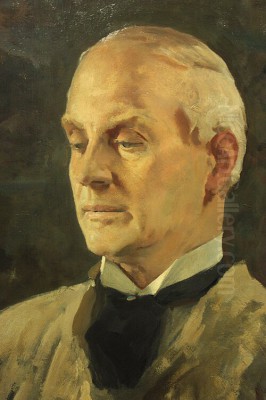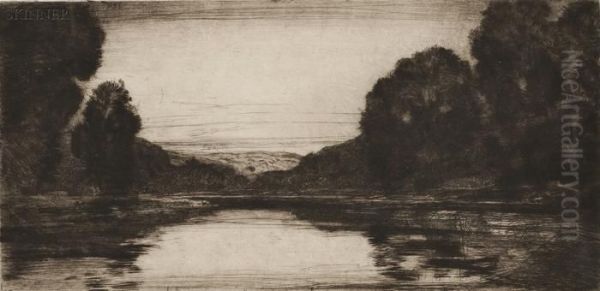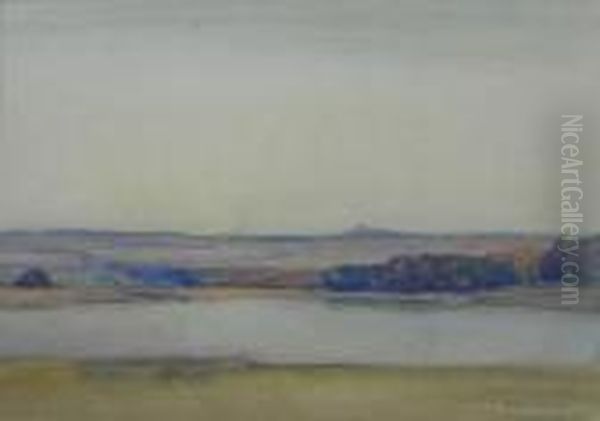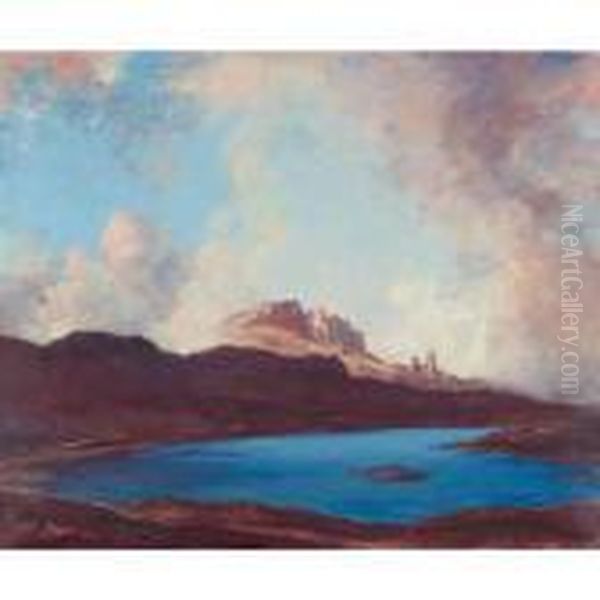
Sir David Young Cameron stands as a towering figure in Scottish art, renowned primarily for his evocative etchings and atmospheric landscape paintings. Active during a period of significant change and revival in British printmaking, Cameron carved a unique niche for himself, mastering the intricacies of etching and drypoint while also developing a distinctive voice in oil and watercolour. His works, characterized by their technical brilliance, compositional strength, and profound sense of place, captured the austere beauty of the Scottish Highlands and the enduring majesty of European architecture, earning him international acclaim and a lasting legacy.
Early Life and Artistic Formation
David Young Cameron was born in Glasgow, Scotland, on June 28, 1865. His father, the Reverend Robert Cameron, instilled in him a sense of discipline and perhaps contributed to the underlying seriousness and spiritual depth often perceived in his work. Though initially steered towards a commercial career, the young Cameron felt an undeniable pull towards the arts. At the relatively early age of fourteen or fifteen, he began his formal artistic training, enrolling part-time at the Glasgow School of Art.
His commitment to art solidified, and by the age of twenty, he had abandoned his business pursuits entirely to dedicate himself to painting and drawing. Seeking further instruction, he moved to Edinburgh to study at the Schools of the Board of Trustees for Manufactures in Scotland, which would later become the Edinburgh College of Art. It was here, around 1885, that he began to seriously explore the medium of etching, a technique that would come to define much of his career. He received crucial early guidance in the medium, quickly grasping its potential for expressive line and tonal depth.

Cameron's formative years coincided with a burgeoning art scene in Glasgow, often associated with the 'Glasgow Boys'. While not formally part of this group, he was undoubtedly aware of their plein-air techniques and their move away from staid Victorian narrative painting towards a more modern, aesthetically focused approach. This environment, coupled with his rigorous academic training, provided a fertile ground for his artistic development. He produced his first dated etching in 1887, marking the beginning of a prolific printmaking career.
The Rise of an Etcher
Cameron emerged as an etcher during the height of the British Etching Revival, a movement that sought to elevate etching from a mere reproductive technique back to a respected original art form. Artists like James McNeill Whistler and Sir Francis Seymour Haden were pivotal figures in this revival, championing the expressive potential of the etched line and the unique qualities of the printed impression. Cameron absorbed these influences, particularly Whistler's emphasis on suggestion, atmosphere, and carefully controlled composition.
He was also deeply impressed by the work of earlier masters, notably Rembrandt van Rijn, whose profound humanity and mastery of light and shadow in etching set an enduring standard. The dramatic architectural etchings of the French artist Charles Meryon also resonated with Cameron, likely influencing his own later focus on monumental buildings and cityscapes. Cameron quickly distinguished himself through his exceptional technical skill, particularly his command of line and his developing mastery of drypoint, a technique where the image is scratched directly onto the copper plate, creating a rich, burred line that yields velvety dark tones in printing.
His early series of etchings, such as the Clyde Set (1889), demonstrated his burgeoning talent and his interest in local scenery. This was followed by travels abroad, resulting in significant bodies of work like the North Holland Set (completed 1892), which captured the distinctive landscapes and fisherfolk of the Netherlands with remarkable sensitivity. These early sets established his reputation as a printmaker of note, showcasing his ability to render diverse subjects with precision and atmospheric effect.
Cameron's technique involved not just meticulous work on the plate but also careful control during the printing process. He became adept at manipulating ink left on the surface of the plate (plate tone) to create subtle variations in light and shadow, enhancing the mood and depth of his images. This painterly approach to printing was characteristic of the Etching Revival and allowed Cameron to achieve a wide range of tonal effects, from delicate silvery greys to deep, resonant blacks.
Architectural Visions

Alongside landscape, architecture became a central theme in Cameron's oeuvre. He possessed a profound appreciation for the structure, history, and atmospheric presence of great buildings, particularly cathedrals, castles, and ancient ruins. His travels provided rich subject matter, leading to important series such as the North Italian Set (1894-96), the London Set (1899), and the Paris Set (1904). These works moved beyond simple topographical recording; Cameron sought to capture the spirit and grandeur of these structures.
His architectural etchings often emphasize soaring verticals, intricate details rendered with fine lines, and dramatic contrasts of light and shadow (chiaroscuro). He was particularly drawn to Gothic and Romanesque architecture, finding in their forms a sense of permanence and spiritual weight. Works like Gateway of Bruges (1907) exemplify his ability to convey the texture of stone, the play of light across complex facades, and the imposing scale of historic entrances.
One of his most celebrated architectural prints is The Chimera of Amiens (1910), depicting one of the famous gargoyles of Amiens Cathedral overlooking the city. This work masterfully combines detailed rendering of the sculpted figure with a suggestive, atmospheric view of the town below, showcasing his skill in both precise drawing and evocative tonal work. Later, his travels to Italy inspired works like Thermae of Caracalla (1923), capturing the monumental scale and evocative decay of the ancient Roman baths.
Cameron's architectural subjects were rarely populated. The absence of figures often enhances the sense of timelessness and focuses the viewer's attention on the structure itself, allowing its inherent character and the effects of light and atmosphere to dominate. He treated buildings almost as portraits, revealing their unique personalities shaped by time, weather, and history. His meticulous approach involved careful observation and drawing, translated onto the copper plate with extraordinary control.
Master of the Scottish Landscape
While his architectural etchings brought him international fame, David Young Cameron remained deeply connected to his native Scotland, particularly its wild and dramatic landscapes. The Scottish Highlands, with their rugged mountains, expansive lochs, and ever-changing skies, provided endless inspiration for both his etchings and his paintings. He developed a profound affinity for specific locations, returning repeatedly to areas like Loch Maree in Wester Ross, capturing their unique moods in different lights and seasons.

His landscape works, whether in print or paint, often convey a sense of solitude, grandeur, and profound stillness. He excelled at depicting the vastness of the Highland scenery, using strong compositional structures, often based on horizontal bands of land, water, and sky. His etchings of Scottish scenes, such as views of Stirling Castle or remote mountain ranges, employ his characteristic precision of line combined with rich tonal variations to suggest the textures of rock, heather, and water under shifting light.
In his oil paintings, Cameron often adopted a broader, more atmospheric approach than in his etchings. Works like Still Waters (an oil painting held in major collections like the Tate and National Galleries of Scotland) exemplify his landscape painting style. These works feature simplified forms, a focus on light and atmosphere, and a subtle, often muted colour palette that captures the specific quality of Scottish light. He rendered the monumental forms of mountains and the reflective surfaces of lochs with a quiet intensity, evoking a sense of enduring calm and majesty.
Cameron's landscapes, like his architectural studies, are typically devoid of human figures, emphasizing the power and permanence of nature. There is often a contemplative, almost spiritual quality to these works, reflecting perhaps his own deep connection to the land and possibly the influence of his religious upbringing. He managed to convey both the austerity and the sublime beauty of the Scottish wilderness, creating images that resonate with a sense of timeless peace.
Travels and Wider Horizons
Cameron's artistic curiosity extended beyond the British Isles and familiar European destinations. While renowned for his depictions of Scotland, Italy, France, and the Low Countries, he also undertook journeys further afield, notably to Egypt. These travels broadened his visual repertoire and resulted in works, particularly watercolours, that captured the distinct light, colours, and architectural forms of different regions.
His watercolours often display a greater freedom and immediacy than his more laboriously produced etchings and oils. In Egypt, he was captivated by the stark desert landscapes, the monumental ancient ruins, and the intense quality of the light. These works showcase his ability to adapt his technique to different environments, using fluid washes and expressive brushwork to convey heat, light, and atmosphere.
These excursions provided fresh perspectives and subject matter, preventing his art from becoming repetitive. The experience of different cultures and landscapes enriched his understanding of form, light, and composition, feeding back into his work across all media. Whether depicting the canals of Venice, the temples of Karnak, or the mountains of Skye, Cameron brought a consistent vision focused on structure, atmosphere, and the essential character of the place.
His travel sketches and watercolours also offer insight into his working process, often serving as preparatory studies or as finished works in their own right. They reveal his keen observational skills and his ability to quickly capture the essence of a scene. This facility with watercolour complemented his mastery of etching and oil painting, making him a versatile artist comfortable across different techniques and subjects.
War Artist and Public Commissions
The outbreak of the First World War saw Cameron contribute his artistic talents to the war effort. In 1917, he was commissioned by the Canadian Government, through the Canadian War Records Office, to serve as an official war artist. His role primarily involved documenting the architectural landscape of the war zones in France and Belgium, focusing on significant buildings affected by the conflict, rather than scenes of active combat.
This commission aligned well with his established expertise in architectural subjects. He produced a series of drawings and paintings depicting ruined churches, shattered towns, and the scarred landscapes of the Western Front. These works, while documenting destruction, often retain a sense of dignity and resilience, reflecting Cameron's characteristic focus on structure and atmosphere even amidst devastation. His war art provides a poignant record of the conflict's impact on the built environment.
Following the war, Cameron's public standing led to further prestigious commissions. He was involved in decorative schemes, including contributing to murals for St Stephen's Hall in the Houses of Parliament in London, a significant national project. His reputation as a leading figure in British art was firmly established, recognized both for his technical mastery and the distinctive vision he brought to his subjects.
These official roles and commissions underscored the high regard in which Cameron was held within the art establishment and by governmental bodies. They acknowledged his ability to handle subjects of national importance with skill and gravitas, further cementing his position as a major figure in early 20th-century British art.
Recognition and Honours
David Young Cameron's artistic achievements garnered significant recognition throughout his career. He was elected an Associate of the Royal Society of Painter-Etchers and Engravers (RE) in 1889, becoming a full Fellow in 1898. His standing in his native Scotland was confirmed by his election as an Associate of the Royal Scottish Academy (RSA) in 1904, followed by full Academician status in 1918.
His reputation extended to the heart of the London art establishment with his election as an Associate of the Royal Academy of Arts (RA) in 1911, and he became a full Royal Academician in 1920. These memberships placed him at the forefront of the official art institutions in both Scotland and England. His work was highly sought after by collectors, and he achieved considerable commercial success during his lifetime, particularly for his etchings, which commanded high prices.
The culmination of his public recognition came in 1924 when he was knighted by King George V for his services to art, becoming Sir David Young Cameron. Further royal honour followed in 1933 when he was appointed His Majesty's Painter and Limner in Scotland, a prestigious historic post within the Royal Household in Scotland.
His works were acquired by major public collections across Britain and internationally, including the British Museum, the Victoria and Albert Museum, the Tate Gallery, the National Galleries of Scotland, and numerous galleries in the United States, Canada, and Australia. This widespread institutional recognition affirmed his importance and ensured the preservation of his work for future generations. Despite this, as noted in some accounts, a portion of his extensive output may remain less visible in museum storage, awaiting rediscovery.
Contemporaries and Connections
D.Y. Cameron operated within a rich network of fellow artists. While influenced by Whistler and Meryon, he was also a contemporary of other major figures in the Etching Revival, such as Muirhead Bone, another highly skilled Scottish etcher known for his architectural and industrial scenes, and James McBey, famed for his fluid, atmospheric prints. He would also have known the work of etchers like William Strang and Sir Frank Short, the latter being an influential teacher as well as artist.
His connection to the Glasgow art scene remained important. Although distinct from the core 'Glasgow Boys' like James Guthrie, Sir John Lavery, George Henry, and E.A. Hornel, he shared their interest in modern approaches to painting and landscape. He maintained correspondence with artists like the painter Thomas Corsan Morton and the wildlife artist Edwin Alexander. He was also associated with the portrait and landscape painter Herbert James Gunn. His family connections included his sister-in-law, Katharine Cameron, who was herself a respected artist, known for her watercolours and etchings, particularly of flowers. His circle also included figures like the painter James Pryde, known for his dramatic architectural compositions.
Cameron's position within the Royal Academy and the Royal Scottish Academy brought him into regular contact with the leading artists of his day. He navigated these institutional structures successfully, maintaining his distinct artistic identity while participating in the broader artistic life of Britain. His influence can be seen in the work of subsequent generations of Scottish landscape painters and printmakers who admired his technical skill and his evocative portrayal of their shared homeland. His relationship with contemporaries appears to have been largely professional and collegial, reflecting his respected status within the art community.
Artistic Style and Technique Revisited
Across his long career and various media, certain stylistic hallmarks define the work of Sir David Young Cameron. Central to his etching was his exquisite draughtsmanship and mastery of line, capable of rendering intricate architectural detail or suggesting the broad sweep of a landscape. His innovative use of drypoint, often in combination with etching, allowed him to achieve exceptionally rich, dark tones and atmospheric effects, contributing significantly to the mood of his prints.
His compositions are invariably strong and carefully considered, often employing dramatic perspectives in his architectural work or balanced, harmonious arrangements in his landscapes. The interplay of light and shadow is a constant preoccupation, used to define form, create depth, and evoke emotion. Whether depicting the stark sunlight on an Italian facade or the soft, diffused light of a Scottish glen, Cameron was a master of illumination.
A defining characteristic, particularly noted by critics, is the frequent absence of human figures, or their diminutive scale if included. This tends to emphasize the grandeur and permanence of nature or architecture, creating a sense of timelessness and contemplative quietude. His palette, especially in his oil paintings, often favoured subtle harmonies and muted tones, although his watercolours could display brighter hues appropriate to their subjects and locations.
While influenced by predecessors like Rembrandt and contemporaries like Whistler, Cameron forged a highly personal style. It combined technical virtuosity, particularly in printmaking, with a romantic sensibility towards landscape and architecture. His work is less concerned with narrative or social commentary than with capturing the essential character and emotional resonance of his chosen subjects, rendered with integrity and profound artistic vision.
Legacy and Conclusion
Sir David Young Cameron left an indelible mark on British art, particularly in the field of printmaking. He was a key figure in the later stages of the Etching Revival, demonstrating the medium's capacity for profound artistic expression and technical sophistication. His etchings and drypoints are considered among the finest produced in Britain during the late 19th and early 20th centuries, admired for their skill, beauty, and atmospheric power.
His evocative depictions of the Scottish Highlands played a significant role in shaping the popular image of that landscape, conveying its unique blend of austerity and majesty. He brought a similar sensitivity to his architectural subjects, capturing the spirit of place with remarkable insight. As a painter in oils and watercolours, he further demonstrated his versatility and his consistent focus on light, structure, and atmosphere.
Knighted for his contributions and holding prestigious positions like King's Painter and Limner in Scotland, Cameron achieved a level of recognition few artists attain. His work remains well-represented in major museum collections worldwide, testifying to his enduring importance. While perhaps less widely known today than some of his contemporaries like Whistler, his reputation among curators, collectors, and connoisseurs of printmaking remains high.
Sir David Young Cameron's legacy lies in his masterful fusion of technical brilliance and poetic vision. Through his prints and paintings, he offered enduring images of natural grandeur and architectural dignity, rendered with a quiet intensity and profound respect for his subjects. He stands as a pivotal figure in Scottish art history and a master of landscape and etching whose work continues to resonate with viewers today. He passed away in Perth, Scotland, on September 16, 1945, leaving behind a rich and significant body of work.